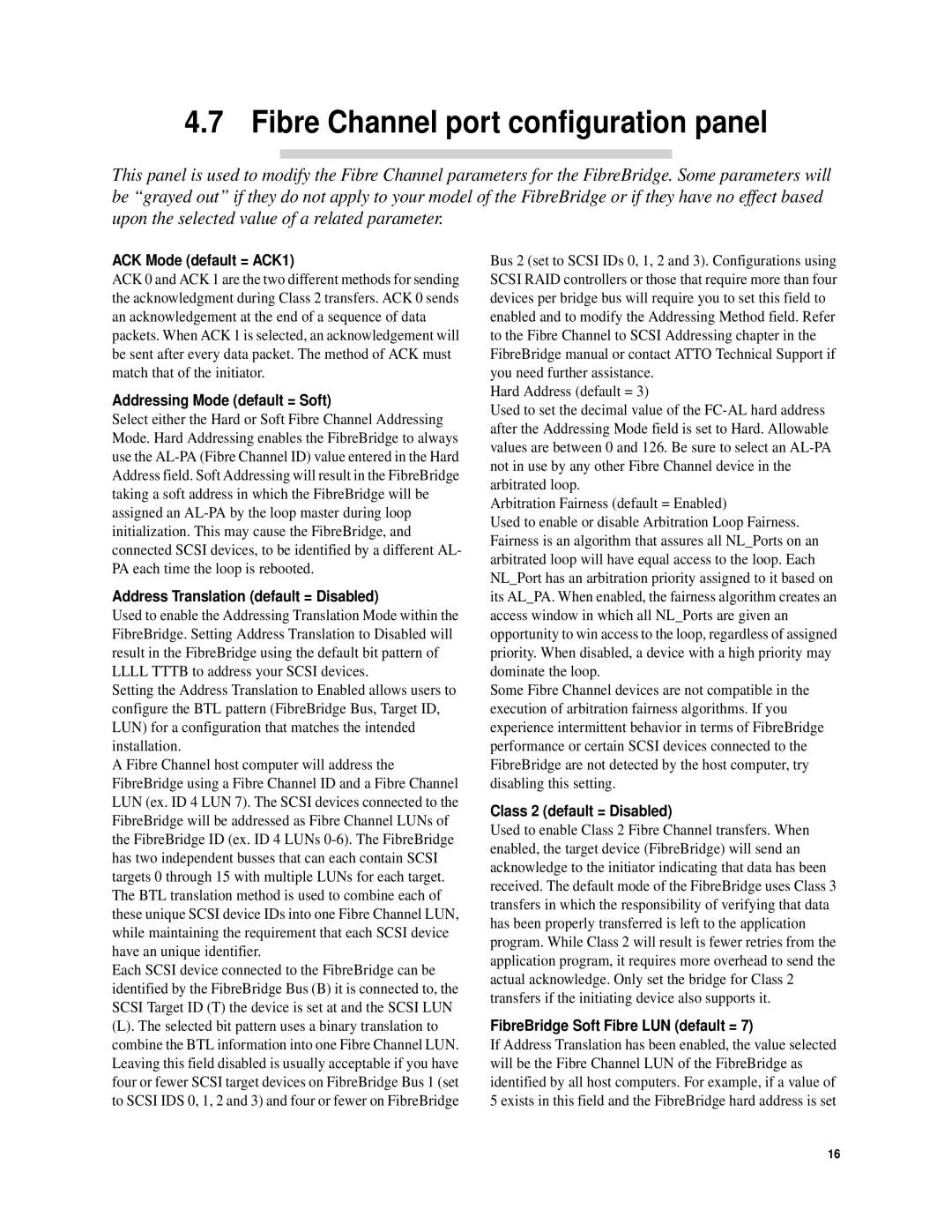4.7 Fibre Channel port configuration panel
This panel is used to modify the Fibre Channel parameters for the FibreBridge. Some parameters will be “grayed out” if they do not apply to your model of the FibreBridge or if they have no effect based upon the selected value of a related parameter.
ACK Mode (default = ACK1)
ACK 0 and ACK 1 are the two different methods for sending the acknowledgment during Class 2 transfers. ACK 0 sends an acknowledgement at the end of a sequence of data packets. When ACK 1 is selected, an acknowledgement will be sent after every data packet. The method of ACK must match that of the initiator.
Addressing Mode (default = Soft)
Select either the Hard or Soft Fibre Channel Addressing Mode. Hard Addressing enables the FibreBridge to always use the
Address Translation (default = Disabled)
Used to enable the Addressing Translation Mode within the FibreBridge. Setting Address Translation to Disabled will result in the FibreBridge using the default bit pattern of LLLL TTTB to address your SCSI devices.
Setting the Address Translation to Enabled allows users to configure the BTL pattern (FibreBridge Bus, Target ID, LUN) for a configuration that matches the intended installation.
A Fibre Channel host computer will address the FibreBridge using a Fibre Channel ID and a Fibre Channel LUN (ex. ID 4 LUN 7). The SCSI devices connected to the FibreBridge will be addressed as Fibre Channel LUNs of the FibreBridge ID (ex. ID 4 LUNs
Each SCSI device connected to the FibreBridge can be identified by the FibreBridge Bus (B) it is connected to, the SCSI Target ID (T) the device is set at and the SCSI LUN
(L). The selected bit pattern uses a binary translation to combine the BTL information into one Fibre Channel LUN. Leaving this field disabled is usually acceptable if you have four or fewer SCSI target devices on FibreBridge Bus 1 (set to SCSI IDS 0, 1, 2 and 3) and four or fewer on FibreBridge
Bus 2 (set to SCSI IDs 0, 1, 2 and 3). Configurations using SCSI RAID controllers or those that require more than four devices per bridge bus will require you to set this field to enabled and to modify the Addressing Method field. Refer to the Fibre Channel to SCSI Addressing chapter in the FibreBridge manual or contact ATTO Technical Support if you need further assistance.
Hard Address (default = 3)
Used to set the decimal value of the
Arbitration Fairness (default = Enabled)
Used to enable or disable Arbitration Loop Fairness. Fairness is an algorithm that assures all NL_Ports on an arbitrated loop will have equal access to the loop. Each NL_Port has an arbitration priority assigned to it based on its AL_PA. When enabled, the fairness algorithm creates an access window in which all NL_Ports are given an opportunity to win access to the loop, regardless of assigned priority. When disabled, a device with a high priority may dominate the loop.
Some Fibre Channel devices are not compatible in the execution of arbitration fairness algorithms. If you experience intermittent behavior in terms of FibreBridge performance or certain SCSI devices connected to the FibreBridge are not detected by the host computer, try disabling this setting.
Class 2 (default = Disabled)
Used to enable Class 2 Fibre Channel transfers. When enabled, the target device (FibreBridge) will send an acknowledge to the initiator indicating that data has been received. The default mode of the FibreBridge uses Class 3 transfers in which the responsibility of verifying that data has been properly transferred is left to the application program. While Class 2 will result is fewer retries from the application program, it requires more overhead to send the actual acknowledge. Only set the bridge for Class 2 transfers if the initiating device also supports it.
FibreBridge Soft Fibre LUN (default = 7)
If Address Translation has been enabled, the value selected will be the Fibre Channel LUN of the FibreBridge as identified by all host computers. For example, if a value of 5 exists in this field and the FibreBridge hard address is set
16
